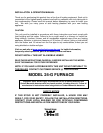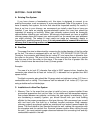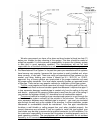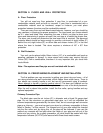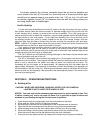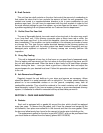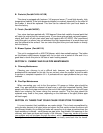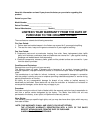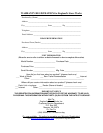
B. Firebrick (Part #AC-LB & AC-SB)
This stove is equipped with fourteen (14) large and seven (7) small high density, high
temperature firebrick. If the brick becomes chipped or cracked, especially on the sides of
the firebox, it should be replaced. This item can be ordered from your local dealer or
from the factory.
C. Finish (Part #AC-MCSP)
Your stove has been painted with 1200 degree Fahrenheit metallic charcoal paint that
will retain its original look for several years. If your stove gets wet and rust spots appear,
simply buff them off with plain steel wool and repaint with AC-MCSP. We recommend
using this paint, as others may not withstand the high temperatures of a wood stove and
may not adhere to the surface. You can order this paint from your local dealer or directly
from the factory.
D. Blower System (Part #AC-18)
This unit is equipped with a 465-CFM blower, which has sealed bearings. The intake
on this blower could become clogged with lint or dust over a period of time and it is a
good idea to check this prior to the start of each heating season.
SECTION VI: CHIMNEY AND FLUE PIPE MAINTENANCE
A. Chimney Maintenance
Cleaning your chimney is not a difficult task, however, we highly recommend a
professional be contacted for this job. He can not only clean the system, but will be able
to perform a complete inspection of it. A professional can spot problems that you may
overlook.
B. Flue Pipe Maintenance
When connecting your unit to the flue system, 24 gauge or thicker pipe should be
used. Your pipe should be cleaned at least once a year and inspected monthly. Most
people will clean their pipe and stove at the end of the heating season, as this will keep
odors from entering the house during the summer months. The flue pipe should be
replaced every three to five years, depending on the thickness of the pipe (thicker pipe
will last longer).
SECTION VII: THINGS THAT COULD CAUSE YOUR STOVE TO SMOKE
It is very important that installations are made airtight. This is best accomplished by
using furnace cement at all pipe joints and where the first section enters the stove and
the chimney thimble. Any existing air leaks will cause the air to draw at points where the
least resistance is offered -- such places are pipe joints, flue thimble, flue openings in the
chimney, ash clean-out doors and cracks in the chimney.
These may cause air to enter
your system and not be drawn through the stove, which could result in a cool chimney,
causing the smoke to build up in the system and eventually come back into the house.



